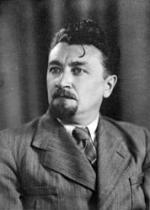
Koretskaya Inna Vitalievna

Mikhailovsky Boris Vasilyevich
Inna Koretskaya and Boris Mikhailovsky Collection
The Museum received this collection in 2004. It is made up of the early 20th-century Russian paintings and drawings bequeathed by Inna Koretskaya (1921 – 2004), a philologist who had been working in the Institute of World Literature of the USSR Academy of Sciences for many years. The Russian journalism of the early 20th century and the Russian symbolist poets were the subject she specialized in. The collection was started in the late1940s by her husband Boris Mikhailovsky (1899 – 1965), the famous historian of literature and arts, Professor of Moscow University and a connoisseur of the Symbolism.
The collection, though not very large, is very representative. It is a kind of museum in itself that gives a comprehensive idea of the Russian Silver Age. The collection of paintings and drawings does not only testify to the exquisite taste of its former owners but also to a good knowledge of the subject that justified the choice of the painters and their works.
First and foremost, it is a collection of the Mir Iskusstva [World of Art] artists: Alexander Benois, Mikhail Dobuzhinsky, Nikolai Roerich, Konstantin Bogayevsky, Nikolai Ulyanov. The collection also features members of the Golubaya Roza [Blue Rose] association who were known to profess Symbolism or be associated with the trend, such as Pavel Kuznetsov, Nikolai Sapunov, Sergei Sudeikin, Martiros Saryan, as well as Konstantin Yuon and Alexey Kravchenko.
Simple and realistic look the Alexander Benois watercolour landscapes The Sea Coast in Brittany and A Chapel in Brittany both dated the summer of 1906 when the artist was staying near Lake Primelle, the place he used to call "divine". A Quiet Corner of Naples was painted by Dobuzhinsky in 1911 when he was travelling in Italy. The painter would remember this Italian town as looking rather like a Spanish one. Nikolai Ulyanov conveyed the impressions of his Italian journey in the gouache study taken from life, St Angels' Bridge in Rome (1913), while Alexey Kravchenko expressed his in the two drawings made in ink and sanguine The Stone Pines of Rome and Above the Tiber (both 1911).
The representation of the artists of the, so to say, Symbolist breed is more consistent. "Doleful, elegant Bogayevsky", whose talent was raised on "the sad soil" of Cimmeria, sees "the paradise that had existed before God created Man". Such of his works as Night. Sudak. (1908) and Sacrificial Altars (1913) echo Maximilian Voloshin's felicitous remarks of his style.
Nikolai Roerich, like Bogayevsky, represented the "archaic line" in Russian art. His sketches for the settings of Stravinsky's ballet "The Sacred Spring" (the 1913 production by the Diaghilev Paris enterprise) and those of "Princess Marlene" (the 1912 production after Maurice Maeterlinck's play) demonstrate Roerich's interpretation of the pre-historic Russia and the mediaeval Europe. The Russian archaism is shown in generalized forms, rhythmically balanced and clear-cut, while the settings for the "Princess Marlene" depicting a rocky descent to the dungeon of an old castle are unique in Roerich's work, for it was the only time that the artist addressed himself to the plays of the Belgian theorist of Symbolism.
As for other works for the theatre, the collection includes the Alexander Golovin large-size sketch of the setting for the 1925 production of "Oedipus the King" by Sophocles at the Academic Drama Theatre, Leningrad. There is a scene of a classical ancient Greek white stone palace set against the background of black rocks with steps running up to the burning altar. Golivin's other work, the lyrical landscape Petrovsko-Razumovskoye. Autumn. (1909), also looks theatrical because of purely decorative composition that uses ornamental forms and intense palette.
The true gems of the collection are thought to be Portrait of Actress Olga Glebova-Sudeikina as Putanitsa from the brush of Sergei Sudeikin (1910) and the Bukhara and Samarkand scenes by Pavel Kuznetsov, namely Acacia in the Sands of Bukhara (The Tree of the Desert) painted in 1909 and Morning in the Steppe (Rain) dated 1912.
Actress-dancer Olga Glebova-Sudeikina is portrayed in the costume of one of her characters, "the soul of an old vaudeville". The artist saw how to use the evident theatricality of the stage costume, a cloak bordered with pretentious ermine fur, to the advantage of showing the sitter's natural tenderness and the true inward beauty. This is a portrait of a stage character and, at the same time, of a real woman who, according to her contemporaries, was a mostly charming, fascinating, person.
The Kuznetsov landscapes belong to the peak of his artistic career that is to the late 1900s –1910s. Their composition is purely decorative but full of brilliant artistic freedom, high poesy and harmony, which allows the painter to put in counterbalance the grandiosity of nature and man's everyday life.
The collection is complete with the graphical portraits of artists and poets. Portrait of Valery Bryusov by Nikolai Sapunov may date 1908 – 1909. Sketches for the portrait are to be found in the Tretyakov Gallery. The one in the collection is probably the author's final variant.
Nikolai Ulyanov's Potrtait of Vyacheslav Uvanov dates 1920. The work of the philosopher poet was the subject of the research by the owners of the collection who found the pose and the eyes in the portrait extremely characteristic of the sitter.
It was in 1921 that Yuri Annenkov performed Portrait of Alexander Benois in ink meant as one of the illustrations for his own memoirs "Diary of My Encounters. A Cycle of Tragedies" first published in New York, 1966. The print of this drawing illustrates the essay about Alexander Benois as an outstanding figure of the Russian art. For any private collector the fact of obtaining an original Yuri Annekov portrait of this series would be an almost impossible luck. Mikhailovsky and Koretsky had one as well as other rarities which are now destined to be the pride of the Museum of Private Collections.





